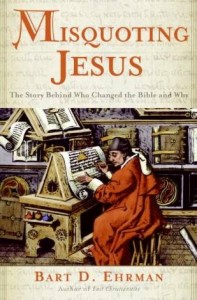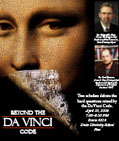 Misquoting Jesus: The Story of Who Changed the Bible and Why by Bart Ehrman
Misquoting Jesus: The Story of Who Changed the Bible and Why by Bart Ehrman
Audio Book
March 13, 2010
© Tom Arthur
Rating: 7 of 10
Bart Ehrman and I have a very similar story, except the ending. Ehrman went to Moody Bible Institute to study the Bible (I almost went there), and then went to Wheaton College to study ancient languages (I too went to Wheaton). From Wheaton Ehrman went to Princeton Theological Seminary to continue to specialize in the ancient languages and textual criticism (I went to Duke and studied similar things, although I am no where near as proficient as Ehrman). The difference is that after Princeton, Ehrman left the Christian faith while after attending Duke, I became a pastor.
 I first heard about Ehrman while at Duke. He was the religion chair at our rival nemesis, University of North Carolina. I heard two professors of mine mention that they disagreed with Ehrman on various things. This intrigued me so I looked into it. Ehrman had just published Misquoting Jesus, and with the Da Vinci Code coming out about that time in its movie incarnation, Ehrman was becoming quite popular. Once I realized who he was I saw or heard him everywhere. He is a regular religious commentator on TV (Stephen Colbert on The Colbert Report had a fun time roasting Ehrman) and radio. He is often interviewed for print and online publications. This is because he is an excellent and careful scholar, and his conclusions match up with the broader culture’s negative conclusions about Christianity.
I first heard about Ehrman while at Duke. He was the religion chair at our rival nemesis, University of North Carolina. I heard two professors of mine mention that they disagreed with Ehrman on various things. This intrigued me so I looked into it. Ehrman had just published Misquoting Jesus, and with the Da Vinci Code coming out about that time in its movie incarnation, Ehrman was becoming quite popular. Once I realized who he was I saw or heard him everywhere. He is a regular religious commentator on TV (Stephen Colbert on The Colbert Report had a fun time roasting Ehrman) and radio. He is often interviewed for print and online publications. This is because he is an excellent and careful scholar, and his conclusions match up with the broader culture’s negative conclusions about Christianity.
 Having been on a journey myself trying to understand what authority the Bible had, I thought it might be fun to put together a “debate” between
Having been on a journey myself trying to understand what authority the Bible had, I thought it might be fun to put together a “debate” between  Ehrman and one of the leading New Testament scholars at Duke, Richard Hays. I was delighted to find out that both of them were up for the challenge. The topic: The Da Vinci Code and the reliability of the New Testament documents. The resulting hype around the event was bigger than we could have imagined (mostly because of Ehrman’s popularity: he was on the New York Times best seller list and the day before had been interviewed by Terry Gross on NPR’s Fresh Air). 500+ people showed up that night, some of them driving from as far as two or three hours away! The resulting debate was fabulous.
Ehrman and one of the leading New Testament scholars at Duke, Richard Hays. I was delighted to find out that both of them were up for the challenge. The topic: The Da Vinci Code and the reliability of the New Testament documents. The resulting hype around the event was bigger than we could have imagined (mostly because of Ehrman’s popularity: he was on the New York Times best seller list and the day before had been interviewed by Terry Gross on NPR’s Fresh Air). 500+ people showed up that night, some of them driving from as far as two or three hours away! The resulting debate was fabulous.
In this book we get insight into Ehrman’s spiritual journey. He begins with a fairly lengthy autobiographical sketch of his reasons for leaving Christianity. This story moves effortlessly into an exploration of those reasons. For Ehrman, the New Testament books are radically compromised. We do not have the originals and enough has been significantly changed both by unintentional mistakes and for intentional theological reasons that the picture the average Christian has of Jesus is simply unhistorical and inaccurate. This book is Ehrman’s attempt to bring these scholarly discussions to a wider lay audience. He accomplishes this project well, although I doubt the average person will have the attention span to delve through all the details.
Let’s take a couple of common examples to make the point. The oldest and most trustworthy manuscripts don’t have the story of the woman caught in adultery found in John 7:53 to 8:11 although most modern translations include a footnote that explains this. Another complicated text is the end of Mark. Again the oldest and most trustworthy manuscripts do not include 16:8b and following. This ends Mark rather abruptly with: “So they went out and fled from the tomb for terror and amazement had seized them; and they said nothing to anyone, for they were afraid.” Again, most modern translations make note of this textual difficulty in a footnote. While neither of these specific instances causes significant problems for the core of Christian belief, Ehrman does bring up other instances that do cause more problems. I’ll leave a description of these instances to the much more capable Ehrman for those who wish to read about them in his book.
At one time in my own faith journey, Ehrman’s book would have completely and totally derailed my faith. I would not have seen how one could possibly continue believing in Jesus when the manuscripts seemed so compromised. Like an earlier Ehrman I believed at one time that the Bible was inerrant and that if it was shown to be “in error” in any place, that it’s entire authority was in question. In this sense, Ehrman and fundamentalists share the same basic philosophical position: errors as defined by modern standards mean that the Bible is not authoritative or trustworthy.
Recently my view of the Bible has changed. This shift is in large part due to Richard Hays and Ellen Davis. Ehrman conceives of what the New Testament is attempting to do as a kind of photographic journalism. Hays describes what the New Testament (especially the Gospels) is attempting to do as a kind of artistic portraiture. Each author gives his (there probably where no “hers”) artistic presentation of Jesus to meet the needs of a particular context. In this way, the Bible has what Peter Enns has called a kind of incarnational quality. It is, like Jesus, fully divine and fully human. The Bible’s authority comes not from it being photographically accurate in describing the events of its day, but in its being a faithful portrait of the one who died and was raised, Jesus Christ, that is consistent with the faith as it has been passed down in the church. The church did come before the New Testament after all and it was the church who saw in both the Old and New Testament an accurate guide for Christians to follow Jesus.
Ehrman’s book has not let me unscathed. Rather, he has pushed me a little back toward exploring the historical accuracy of the text itself. Since reading Ehrman’s book I have picked up a copy of Bruce Metzger’s A Textual Commentary on the New Testament and now take the time to look up particular textual problems on any text I am preaching or teaching, but Ehrman’s fundamental thesis no longer causes me significant problems because I no longer accept his starting point philosophical assumptions. If you are someone who believes in the inerrancy of scripture, then this book will challenge you in some very significant ways. Ehrman is a very careful scholar and his arguments carry weight. Plan to spend a lot of time reading other books (there are several out there that attempt to refute Ehrman in his own arguments) to keep your faith intact. If, like me, you have left inerrancy behind, Ehrman who is a close and careful reader of scripture will enlighten many texts and provide you with many thoughts to ponder, and he will do so in a way that is easy to understand and follow.
Currently Reading/Listening:
Playing the Enemy (audio book) by John Carlin
Screwtape Letters (audio dramatization) by C.S. Lewis
American Saint: Francis Asbury and the Methodists by John H. Wigger
An Introduction to Pastoral Care by Charles V. Gerkin
Gulliver’s Travels by Jonathan Swift
The Forgotten Ways by Alan Hirsch
The New Consecration Sunday by Herb Miller

[…] on the history of early Christianity. I have read other books of his and written about him here. This audio class, distributed by The Teaching Company, is Ehrman’s Early Christianity course […]